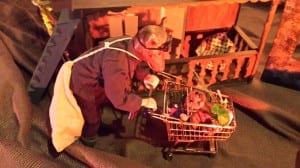Animal-human hybrid art

Carnival at the end of the World scares you straight to hell
Author: Liam Fitz-Gerald
From Sept. 27 until Oct. 26, the MacKenzie Art Gallery hosted the University of Regina MFA Series; a program where a student completing the degree of Master of Fine Arts (MFA) can have their work exhibited at the Gallery. This year, Sylvia Ziemann’s Carnival at the end of the World was showcased. While Ziemann ultimately hoped her piece would be about hope, it still sent shivers down my spine as I viewed it on Friday morning.
Held in a dark room, Carnival at the end of the World was composed of three parts: a small town of model houses with various mutants (animal-human hybrids according to the artist) living among them, a small model house on a table with the sign “Freaks and Wonders” hanging over it, and a projector showcasing a rodent-human hybrid playing cards with a creature with antlers. It is reminiscent of Medieval and Early Modern depictions of Hell with various animals and deformed creatures there to greet the unfortunate souls destined for damnation.
Indeed, according to Ziemann, if contemporary consumerism continues as it is, that’s where the modern West may find itself.
“We are so dependent on shopping for what we need that we have sacrificed our ability to be resourceful. If this system failed as it has done in the past (depression era of the last century), would we remember how to make our own food and clothing? How would we survive?” she said.
Ziemann constructed a morality tale, similar to Renaissance artists Hieronymus Bosch and Pieter Bruegel – artists who clearly influenced her both in style and in spirit. These artists interwove their depictions of everyday life with morality tales. Ziemann imbues her art with an ethics story of her own: unfettered consumerism and its aftermath.
Yet, she wants viewers of her work to take hope and optimism, not fear, away from it. To her, this is a world where animal/human hybrids have tried to make the best of their situation by working together to build a better world, “even amid disaster and loss.” The creatures work and take care of each other but enjoy the small things in life.
“My creatures are happy and have adapted to the changes in their world despite the unnamed disaster and loss of technology. I hope people will look at their own lives and consider what is essential in living a happy and useful life,” Ziemann said, emphasizing that humbler, caring communities may be the key for more people to have happier lives.
Still, her world is quite frightening and the creatures living within it seem like they dwell within nightmares. The use of light to highlight shadows and the interjection of darkness with the colourations of buildings was particularly well done. Various details ranging from a table of cards to a market of sorts add a further flare of realism to the piece.
What’s scarier about her work is that the fate of contemporary society as she depicts it is preventable, yet despite warning after warning and chance after chance, many people bury their heads in the sand, pretending that a crisis isn’t coming. The world can change to prevent catastrophe, or it can change after one, but I think the former is preferable.










